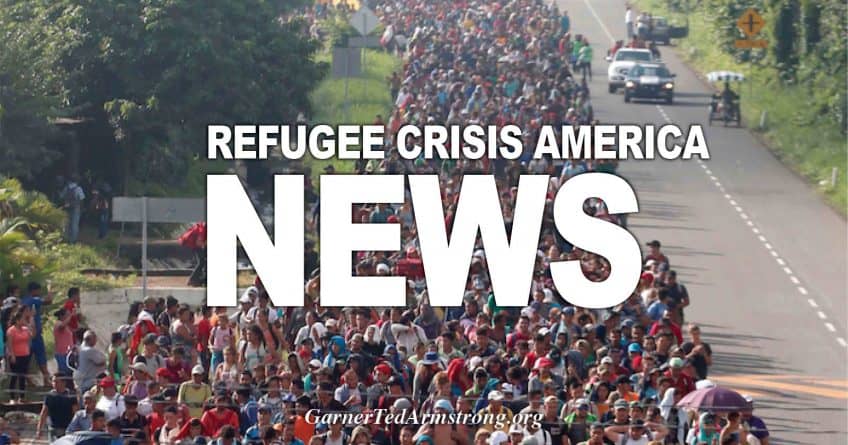Like the United States, most developed countries are shifting away from respecting refugees’ rights at the border to trying to prevent migration in the first place
Biden’s not alone. My recent book shows that the United States is part of a global trend in spending billions to prevent migration — rather than respecting refugees’ human rights, as required by international law.
Migration aid doesn’t change the root causes of migration
Biden’s immigration plan includes $4 billion for Central American countries to help reduce economic inequality, natural disasters, and civil wars, on the assumption that these push people to migrate.
But there is little evidence that such aid can accomplish its goals.
First, it would take an astronomical amount of money to improve Latin American economies enough to remove the financial incentive to migrate. Even if aid improves local economies, increased income often prompts more people to migrate, giving the poorest citizens enough resources to travel.
Second, climate models suggest that enormous numbers of people will be displaced over the next 50 years. Very little is being invested in relocating communities at risk or preventing the devastation from increased tornadoes, hurricanes, droughts, and so on. Humanitarian aid for climate migrants won’t reduce the increasing global temperatures, rising sea levels, and violent weather events to come.
Some migration aid aims to improve governance and reduce conflict, so that more citizens feel safe in their home countries, and make accountability a condition for such aid. But it’s unclear that this can reduce government corruption, police complicity or gang violence. Some projects actually pay authoritarian regimes to build biometric ID databases, surveillance drones, and other border technologies to prevent people from leaving their countries.
The United States’ poor record on asylum seekers’ rights
While Biden’s migration aid may have short-term humanitarian outcomes, it ignores America’s legal commitments to asylum seekers. The 1951 Refugee Convention, signed by 145 countries, outlined legally binding rights and norms for those in need; the 1980 Refugee Act ratified much of the convention into U.S. law. As a result, every person who comes to the U.S. border and asks for protection is legally entitled to a “credible fear” interview; if their persecution is found credible, they are entitled to a case review by an immigration judge. Under U.S. law, people have the right to cross the border undocumented in order to apply for asylum.
But under President Donald Trump and now Biden, asylum seekers are denied these rights. For example, Biden has retained Title 42 expulsions, which Trump invoked on March 20, 2020, to push asylum seekers across the border because of coronavirus fears. This makes asylum hearings all but impossible for most individuals (excluding unaccompanied children and families) arriving at the U.S. border today.
Further, under international law (and U.S. law before Trump), asylum seekers who are victims of gangs or domestic violence should be granted protection if they cannot seek protection from their home countries. This is particularly important in Central America, where corrupt police and government officials are complicit in violence. Biden has yet to end Trump-era rules barring these asylum claims.
A global shift from rights to aid
Like the United States, governments around the world have shifted migration policies, abandoning many commitments to refugees’ rights, and instead attempting to prevent migration in the first place. For instance, after two years of negotiation, in 2018 more than 150 governments adopted the Global Compact for Safe, Orderly, and Regular Migration and the Global Compact on Refugees. The first asks governments to share best practices and invest development aid to prevent migration. In the second, governments agree to voluntarily pledge “financial, material and technical assistance” every four years at the Global Refugee Forum.
But neither compact reaffirmed key refugee rights, like banning child detention or prohibiting deportations back to life-threatening circumstances. During negotiations, governments couldn’t agree on a way to equitably share the burden of hosting refugees by committing to resettlement quotas or funding; they even removed “responsibility sharing” from the compact’s proposed title.
How will states guarantee protection for asylum seekers who cannot make it to their borders? What protections do migrants have who do not meet the narrowest refugee definition but are still vulnerable? The compacts are silent on these issues.
Misuse of migration aid
While Trump rejected the compacts and Biden has yet to sign on, the current U.S. administration has used rhetoric similar to that in the compact, framing Biden’s migration policies as “safe, orderly and humane.” Aid might buy allies in the region, but what kind? The administration may lean on local leaders, many authoritarian, to prevent migrants from leaving, as the Trump administration did through agreements with Guatemala, Honduras, and El Salvador. Some studies show that, instead of making their citizens’ lives better, corrupt regimes often embezzle foreign aid or redirect it to security forces, leading to more state violence and repression. This approach builds walls to keep people in their home countries rather than reducing the reasons they flee.
The European Union has tried this strategy for years without success. During the 2015 migration crisis, it launched the E.U. Trust Fund for Africa to prevent irregular migration by pouring money into projects on migration management, economic empowerment, and youth employment throughout Africa. Five years and nearly 5 billion euros in aid later, numbers of asylum seekers are down. Refugees stopped arriving in Europe when Turkey agreed to prevent them from traveling further, not because migrants’ home countries improved. Similarly, authoritarian governments in Mexico, Guatemala, Honduras, and El Salvador could use the aid to prevent potential migrants from leaving or transiting their countries rather than making their lives more prosperous and secure.
Nicholas R. Micinski (@nickmicinski) is an assistant professor of political science and international affairs at the University of Maine.
[Disclaimer]







